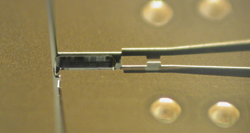
There are many techniques for measuring microwave power, with different methods most suited to different applications. Some have advantageous features for portability, speed of response, or cost, and these are seen in many production power sensor systems. As a manufacturer of calibration systems, TEGAM chooses to research measurement methods that result in the lowest total uncertainty and clearest traceability to the SI units.
For many years, the two thermistor coaxial bolometer has been the arrangement providing lowest uncertainty with straightforward traceability. As TEGAM worked toward a 50 GHz, 2.4 mm calibration system, TEGAM engineers developed a new system that provides the uncertainty and traceability benefits of the thermistor bolometer, while using modern electronic manufacturing techniques to control reflections.
The key to a two-thermistor bolometer is splitting the RF power such that it divides between the two thermistors. The historic arrangement involves bifurcating the center conductor of an air line and then hanging thermistor beads in interruptions on the two sides of the center conductor. In the new design, an innovative launcher structure splits the incoming RF from a 1.85 mm air line to a pair of coplanar waveguides that mirror each other on opposite sides of a thin Quartz substrate. The launch design minimizes reflection caused by the split of RF power, and results in the use of a narrow planar conductor that is much more suitable for matching with a thermistor.
The new design is at the heart of the TEGAM 1510A and 2510A calibration standards. The units are temperature controlled coaxial RF feedthrough and terminating power transfer standards that enable the precise measurement of microwave power in the 10 MHz to 50 GHz frequency range.
TEGAM,
Geneva, OH
(800) 666-1010,
www.tegam.com
